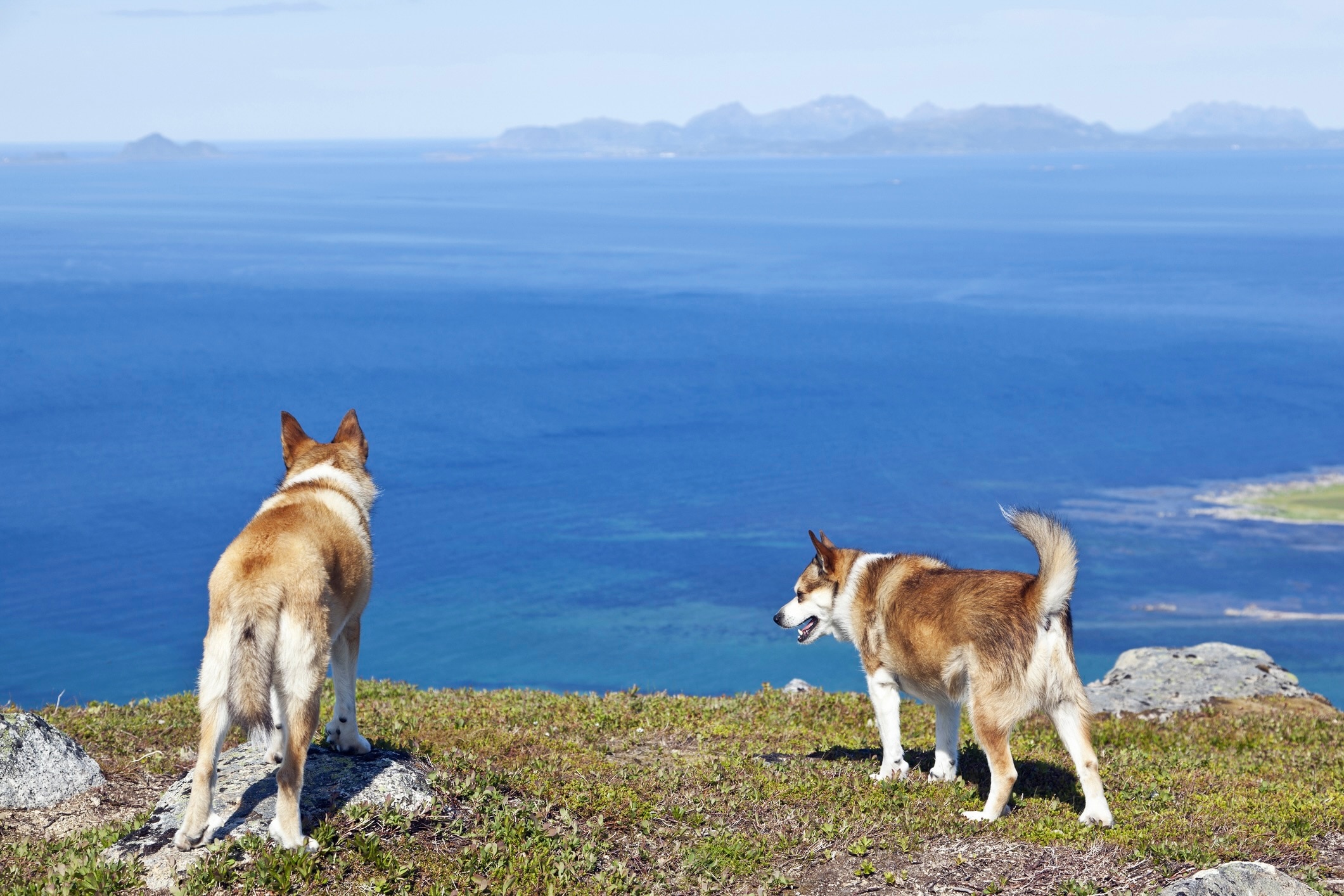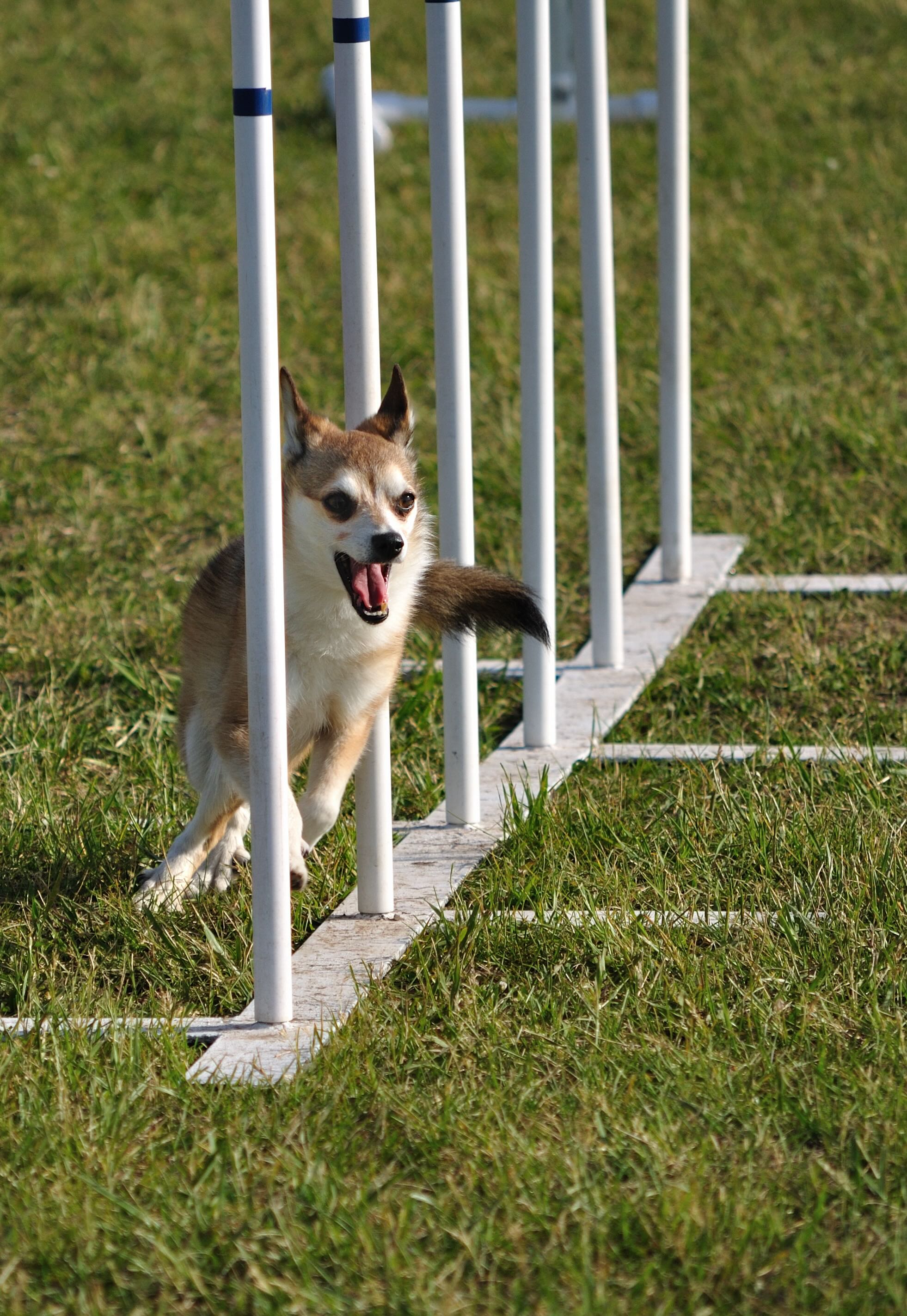Norwegian Lundehund
Adobe Stock/Radomir Rezny
The Norwegian Lundehund dog is a small Spitz-type dog breed that reaches 12–18 pounds and stands 12–15 inches tall. Originating in Norway, these dogs are sometimes referred to as Lundies or Puffin dogs, with the latter nickname reflecting the dog’s heritage as a capable Puffin retriever for Norwegian hunters.
A fox-like appearance is likely to be the first thing you’ll notice about this breed, but it’s not their only unique physical feature.
“Lundies have physical characteristics found in no other dog, including six fully developed toes on all four feet, an extremely flexible spine and shoulders, and ears that fold completely shut,” says Kristina Maze, a member of the Norwegian Lundehund Association of America (NLAA) and owner of two Norwegian Lundehunds.
These adaptations—especially the Norwegian Lundehund’s feet—were especially helpful to the breed as they navigated rocky crags and caves, hunting for puffins.
Caring for a Norwegian Lundehund
The Norwegian Lundehund’s small stature makes these dogs adaptable to life in an apartment or a house, but they do require regular exercise to expend their energy and challenge their mind. Lundies are also known for their loyal and playful disposition, making them good family dogs.
The breed’s grooming needs are minimal, but they are susceptible to a few gastrointestinal (GI) issues, meaning special care must be paid to their diet. With proper care, the average Norwegian Lundehund lifespan is 12–15 years.
Norwegian Lundehund Health Issues

Norwegian Lundehunds don’t suffer from a wide array of health problems, but they are prone to gastrointestinal issues. Pet insurance is a wise investment for treating GI conditions and covering routine blood work for monitoring, says Susan Torgerson, a Norwegian Lundehund breeder and retired veterinarian.
Protein-Losing Enteropathy (PLE)
Also known as intestinal protein loss, PLE is a condition caused by excessive amounts of proteins leaking into the intestinal tract. The most common conditions that lead to PLE include:
-
Infections
-
Inflammatory bowel disease
The most common symptoms of PLE include diarrhea, lethargy, and weight loss. Treatment or management of intestinal protein loss depends on your dog’s underlying condition diagnosis.
Inflammatory Bowel Disease (IBD)
Inflammatory bowel disease in dogs is caused by chronic irritation in the intestinal tract, which interferes with proper nutrient absorption. This can cause:
-
Diarrhea
-
Weight loss
-
Swelling of the limbs
-
Blood clots (in extreme cases)
Low levels of albumin (a blood protein) and anemia are among the factors that can indicate IBD. This is why frequent blood tests are often recommended for Norwegian Lundehunds.
IBD is diagnosed with imaging, such as an ultrasound and/or intestinal biopsies. While there’s no cure for IBD, it can be managed through medications and diet changes.
Small Intestinal Bacterial Overgrowth (SIBO)
Because Norwegian Lundehund dogs are prone to intestinal protein loss, small intestinal bacterial overgrowth frequently becomes a problem as well.
SIBO occurs because the undigested nutrients passing through the digestive tract are used by harmful bacteria, causing a rapid population growth of these undesirable bacteria. Oral antibiotics are the most common treatment for SIBO.
Dogs with SIBO often have chronic diarrhea, often lasting weeks to months.
What To Feed a Norwegian Lundehund
Like all dogs, Norwegian Lundehunds will benefit from a high-quality diet that meets the nutritional standards outlined by the Association of American Feed Control Officials (AAFCO). However, it’s wise to ask your veterinarian for specific dietary guidance, especially if your Lundie deals with intestinal problems.
How To Feed a Norwegian Lundehund
You should feed a Norwegian Lundehund two meals each day of dog food appropriate for your pet’s life stage (puppy, adult, or senior). Norwegian Lundehund puppies may need to eat more frequently—up to four times every day.
Because the breed has a sensitive digestive tract, it’s important not to ignore your veterinarian’s advice on the type and quantity of food.
How Much Should You Feed a Norwegian Lundehund?
A healthy Norwegian Lundehund needs enough calories to maintain their active nature; it’s usually best to follow the feeding guidelines for the specific dog food formula you choose or consult your veterinarian.
Keep in mind that if you notice lethargy or weight loss, increasing caloric intake may not be the answer; these are often symptoms of gastrointestinal issues. Make an appointment with your veterinarian right away if your Lundie is experiencing these changes.
Nutritional Tips for Norwegian Lundehunds
Your veterinarian is in the best position to recommend specific dog supplements for your Norwegian Lundehund.
Because of the breed’s tendency to experience SIBO, a probiotic supplement may help maintain the population of beneficial bacteria in your dog’s gut. If blood work shows low levels of B12 as a result of SIBO, your vet might also suggest B12 injections.
Never give your dog a supplement without talking with your vet first.
Behavior and Training Tips for Norwegian Lundehunds
Norwegian Lundehund Personality and Temperament

A Norwegian Lundehund is best described as alert, independent, and inquisitive. They have a reputation for being active enough to keep up with activities like hiking and long walks, but they’re also happy to settle down inside the house.
With proper socialization, a Lundie’s playful nature means they can get along with other pets and children. But with strangers, these dogs can be aloof and reserved.
Norwegian Lundehund Behavior
Most Norwegian Lundehund dogs have a balanced disposition that isn’t overly hyperactive, skittish, or needy. While these dogs do enjoy time spent with their pet parents, they’re not overly affectionate or cuddly; Maze says a Lundehund lap dog is rare.
They are alarm barkers and will alert you to unfamiliar sights and sounds, but they are not prone to nuisance barking—if they get enough exercise and mental stimulation to prevent boredom.
Norwegian Lundehund Training
Because Norwegian Lundehund dogs are independent and smart dogs, consistency, adaptability, and positive reinforcement are important in the training process.
“Lundies are very smart but clever,” Torgerson says. “They learn quickly, but then ask, ‘Why?’” Motivation is key: dog treats, toys, or even praise and petting your dog can be excellent training aids.
Patience is a must when training a Norwegian Lundehund, and Maze says the dogs can take longer to potty train and leash train than some other breeds due to their independent nature. “Training has to be consistent and in short intervals, sprinkled with lots of praise,” she says.
Because of these training challenges, a Lundie is not always the best choice for a first-time pet parent. But guidance from an experienced dog trainer can help.
Fun Activities for Norwegian Lundehunds
Norwegian Lundehund Grooming Guide
Norwegian Lundehund dogs have a short, dense double coat that’s weather-resistant, low-maintenance, and sheds moderately. The coat typically ranges from fallow (a pale brown) to tan or reddish-brown, with black-tipped hair that darkens as the dog matures.
Skin Care
Norwegian Lundehunds don’t require special skin care, and their double coat does an excellent job of repelling dirt and protecting the skin underneath. An occasional bath might be needed when a Lundie becomes especially dirty from outdoor activities.
Coat Care
Brushing your dog a couple times each week is typically all that’s needed to maintain the Lundie’s coat. Doing so will distribute oils to promote shine, reduce shedding, and remove dander.
Twice a year, a Norwegian Lundehund dog will shed a lot more than usual; in fall and spring, you may need to increase the frequency of brushing.
Eye Care
You won’t typically need to give a Norwegian Lundehund any specific eye care. That said, you should regularly check the eyes for cloudiness, irritation, or discharge.
If you notice a change in your dog’s eyes, contact your veterinarian right away.
Ear Care
The upright ears of the Norwegian Lundehund dog are unique for their ability to fold flat against the head, but there’s no specific ear-care regimen required for this breed.
While brushing your dog, inspect the ears for signs of an ear infection or irritation. You’ll need to clean your dog’s ears after they’re in water (such as after a bath) with a veterinarian-recommended ear cleaner.
Considerations for Pet Parents
The unique appearance, inquisitive personality, and compact size of the Norwegian Lundehund makes them an appealing pick for a small but sturdy dog breed. But it’s important to consider all aspects of the breed’s temperament and care requirements before you start looking for a Norwegian Lundehund puppy.
“They are difficult to house train, and their GI disease needs a more experienced dog person,” Maze says. With that in mind, Lundies may not be the best pick for new dog parents or if you’re wary of navigating the breed’s health challenges.
Norwegian Lundehund FAQs
Why is the Norwegian Lundehund so rare?
Norwegian Lundehunds are very rare because of the breed’s small population in their homeland of Norway. These dogs were once commonly kept as hunting dogs because of their adept ability to retrieve puffins. But when puffins became endangered and hunting them was outlawed, the breed fell out of popularity.
What is special about a Norwegian Lundehund?
A Norwegian Lundehund has a combination of unique physical attributes not found in other purebred dogs: six toes, a highly flexible neck and shoulder joints, and ears that close on demand. These attributes were helpful when the dog would enter tight spaces or when climbing rocky slopes in search of puffins.
How much does a Norwegian Lundehund cost?
The Norwegian Lundehund price varies significantly based on the breeder—and the greater challenge may be finding a reputable kennel with Norwegian Lundehund puppies.
There are very few Norwegian Lundehund breeders in the U.S., so you may have to import a puppy from Europe if you’re serious about the breed. When available, you can expect to pay $1,000 or more for a Lundie puppy.
